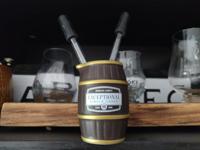TLDR
Should you swirl whisky in the glass or not?
We don't recommend the swirling or whisky glasses, while this does excite the spirit you will inhale mainly ethanol which can overpower or 'burn' your nose alcoholic hiding other aromas. In general we would instead recommend using a whisky eyeglass to allow the aromas to build up.The Long Read
Contents

What are the benefits of swirling whisky in your glass?
The proponents of swirling whisky point out that whisky react with oxygen just like wine in the glass. By briefly swirling the nosing glass, the whisky comes into contact with more air more quickly, evaporation is increased for a short time and hidden aromas come to light. Brian Kinsman, the master blender at William Grant & Sons explains that “This is important because the whisky has been trapped in a cask or bottle all its life and now needs some time to unfold itself and show its true qualities”.
In addition to the smell, the viscosity of the whisky can also be determined when panning. By swirling the whisky, the shape of the drops running down the edge of the glass (called “tears” or “legs”) are formed by the movement of the whisky in the glass. The longer these are, the higher the alcohol content is. They also indicate a good texture, i.e. a good mouthfeel. At least that’s how whisky veteran Charles MacLean sees it in his “Nosing Course” for whisky Magazine (no longer online).
Now, of course, there is another difference between rotating the whisky glass slowly around in order to moisten the glass walls and actually tossing the whisky around wildly. Though some whisky experts such as Richard Paterson (Master Blender of Whyte & Mackay) swirl so excessively that one can even describe this as throwing the spirit. However with these wild movements, the effect is more showmanship than a method of improving the nosing and tasting the single malt. And it’s unlikely anyone will actually want to sink the first poured sip of Dalmore 18 Years on to their living room carpet at home…
The Cons of swirling whisky
Swirling whisky also has disadvantages: the alcohol contained in the whisky dissolves and rises as a result of the movement. If you now hold your nose to the glass, then during the nextfew nosings you will inhale mainly ethanol - this often completely overshadows the other aromas of the malt. After swirling, it is therefore advisable to give the whisky some time to allow the alcoholic notes to dissipate.
Meanwhile, the team over at bourbonsippers.com carried out an interesting experiment: They put two samples of Knob Creek Single Barrel to the test. American whisky was served in four flavors: Decanted, Aerated, Swirled, and Unswirled. It turned out that the testers liked the samples poured unspectacularly into the nosing glass best. The tossed bourbon performed the worst. This is certainly not a representative test, but it is an indication that you should not do too much with your whisky or whiskey in the glass (apart from tasting and drinking it, of course).
Wine swirling versus whisky swirling
In this context, one should pay particular attention to the differences between wine and whisky: Wine contains significantly less alcohol and changes its character and taste relatively quickly under the influence of air, which is why it is often decanted. Spirits, on the other hand, react much more slowly than wine with the oxygen. For this reason, open wines have to be consumed within a few days, but under good conditions open whiskies can be stored for up to a year or more without loss.
Why We Don’t Swirl Our whisky When It Comes To Malt Whisky
At our tastings, we usually don’t swirl the samples because we have also observed that alcoholic notes in particular are released from malts that have been stirred beforehand. And they bother the nose and hide other aromas. In any case, it makes little sense to want to speed up a tasting by faster aeration: We prefer to give the whisky in the glass the natural time it needs for its aromas to develop. Again and again we smell the glass: because the development of whisky over a period of time can be exciting and provide important insights. So it’s worth sniffing the nosing glass again and again before the sample finds its way to the palate.
Ultimately the arguements in favour of swirling your whisky aren’t especially convincing, but as with so much in the whisky it’s a matter of preference. We wouldn’t recommend mixing whisky from a lost distillery with coke, but we won’t go so far as to try and stop you.

